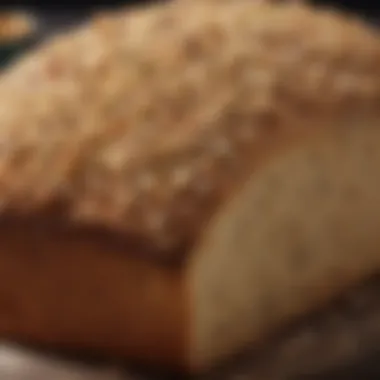Quinoa Bread: A Unique Culinary Adventure


Intro
Quinoa bread has emerged as a star in the culinary scene, appealing not just to health enthusiasts but also to everyday cooks looking for something novel. Touted for its rich nutritional profile, this bread opens up a world of baking possibilities. It’s not just another gluten-free alternative; quinoa bread brings unique flavors and textures, making it a delightful addition to any meal.
Understanding quinoa’s roots is crucial in appreciating its versatility as an ingredient. Originating from the Andean region of South America, quinoa was revered by ancient civilizations who referred to it as the "mother grain." As we rekindle a connection with ancient grains, quinoa takes center stage not only for its health benefits but also for its adaptability in various recipes.
This article aims to demystify quinoa bread, guiding both seasoned bakers and novices alike through its preparation methods, ingredient considerations, and ways to enhance its flavor. Get ready to dive into the intricacies of creating quinoa bread at home, from ingredient selection to baking techniques – allowing everyone the chance to enjoy this wholesome bread that resonates with culinary traditions.
As we navigate through this exploration, we will:
- Highlight the nutritional advantages of quinoa and its applications in baking.
- Discuss essential techniques for mastering quinoa bread baking.
- Provide insights on how to compare quinoa bread with traditional wheat-based breads.
- Share innovative recipes to inspire your culinary creativity.
Let’s embark on this delightful journey through the world of quinoa bread.
Understanding Quinoa: A Nutritional Overview
Quinoa has carved out a significant niche in the culinary world, presenting itself as both a trendy ingredient and a nutritional powerhouse. In this section, we delve into the multifaceted aspects of quinoa, particularly its origins, its health advantages, and its compatibility with various dietary requirements. Grasping these elements is crucial for anyone looking to incorporate quinoa bread into their diet, whether for its health benefits, dietary restrictions, or simply as a means to engage in a wholesome culinary endeavor.
The Origin of Quinoa
Quinoa traces its roots back thousands of years to the Andean region of South America, specifically in countries like Peru and Bolivia. Originally cultivated by ancient civilizations, it was referred to as the "mother grain" by the Inca people, who recognized its vital role in their diet and culture. This humble seed has managed to transcend time and geography, rising to prominence in today's global kitchen.
The seeds of quinoa are technically not grains but rather pseudo-cereals, similar in use but distinct in their growth and processing. They are typically small, round, and come in various colors including white, red, and black. The versatility of quinoa has made it a sought-after ingredient, not only in traditional dishes but also in contemporary baking, especially as a means to create gluten-free alternatives like quinoa bread.
Nutritional Benefits of Quinoa
Quinoa offers a smorgasbord of nutritional benefits that make it a worthy addition to any diet. One of its most notable features is its high protein content; it contains all nine essential amino acids, which makes it an ideal protein source for vegetarians and vegans. This complete protein nature of quinoa supports muscle repair and overall health, crucial for active individuals or those recovering from illness.
Apart from protein, quinoa is rich in fiber, helping to promote digestive well-being. A single serving can deliver a good dose of essential vitamins and minerals, including magnesium, iron, and B vitamins. This nutrient density contributes to feelings of satiety, making quinoa a smart choice for those looking to maintain weight or improve their overall health.
Moreover, quinoa is packed with antioxidants, which serve to protect the body from oxidative stress, potentially reducing the risk of chronic diseases. This unique blend of nutrients is what makes quinoa not just a food choice, but a health-enhancing one.
Quinoa and Dietary Needs
The adaptiveness of quinoa means it fits snugly into a variety of dietary patterns. For instance, its gluten-free nature makes it a go-to option for those with celiac disease or gluten sensitivity. Many people are turning to quinoa as a grain alternative that yields nutritious and satisfying bread without the worry of gluten reactions.
Quinoa also caters to diverse dietary preferences like vegetarianism and veganism, thanks to its protein-rich profile. Additionally, since it possesses a low glycemic index, it can be a suitable option for individuals monitoring their blood sugar levels.
For those venturing into health-focused diets, such as the paleo or Mediterranean diet, quinoa serves as a robust base ingredient for a multitude of meals.
In summary, quinoa isn't just a trend; it's a valuable food that appeals to a wide range of dietary needs while providing the essential nutrition many seek.
The importance of understanding quinoa's nutritional overview cannot be understated, especially for those embarking on the journey of creating quinoa bread. It is more than raw ingredients; it is about nurturing health and wellness through thoughtful culinary choices.
The Basics of Baking Quinoa Bread
When it comes to baking quinoa bread, understanding the foundational elements is crucial. The basic concepts and techniques set the stage for not just a successful bake but a rewarding culinary experience. This section will explore the various components that make each loaf of quinoa bread not only delicious but also nutritious.
Choosing the Right Ingredients
The heart of any good bread lies in its ingredients. Quinoa bread is no different. Opting for high-quality, fresh components can elevate the final product. Start with quinoa flour, derived from ground quinoa. It offers a nutty flavor and a distinct texture that will distinguish your bread from traditional varieties. Moreover, select additional flours, like almond or brown rice, to blend with quinoa flour. These can enhance texture and flavor but make sure they complement rather than overshadow the quinoa’s unique profile.
When it comes to liquids, you might usually reach for water or milk, but consider using plant-based options like almond milk or coconut milk for a creamier taste. Eggs are often left out to cater to vegan diets, but chia seeds or flaxseed mixed with water can serve as a great binding agent. Don't overlook sweeteners like natural honey or maple syrup, which can bring out the rich flavors in the bread.
In summary, a thoughtful selection of diverse yet complementary ingredients will create a masterpiece that showcases the potential of quinoa bread.
Essential Baking Tools
The right tools can make or break your baking adventure. Although quinoa bread can be made with common kitchen items, investing in a few essential tools will definitely make life easier and the end result more satisfying.
- Mixing Bowls: A set of various-sized bowls will aid in combining your ingredients systematically.
- Measuring Cups and Spoons: Precision is key in baking. Make sure you have both dry and liquid measuring tools.
- Sifter: This ensures your flours are light and fluffy, helping to incorporate air into the batter.
- Wooden Spoon or Spatula: Perfect for mixing without damaging your bowls.
- Loaf Pan: Choose a non-stick option or line it with parchment paper to ease the transition of bread from pan to plate.
- Oven Thermometer: Ovens can be tricky beasts; ensure yours is delivering the right temperature for efficient baking and proper texture.
Having these tools at your disposal will transform the way you approach baking quinoa bread and lead to greater success.
Understanding Quinoa Flour
Quinoa flour is crucial in the baking of quinoa bread; it’s not merely an ingredient but a star player. Ground from the seeds of the quinoa plant, this flour boasts a unique set of attributes.
First off, quinoa flour is naturally gluten-free, making it a godsend for those with gluten sensitivities or celiac disease. When you delve into the details, you’ll also find that it carries a protein punch that traditional wheat flours often lack. Additionally, quinoa is abundant in essential amino acids, which are the building blocks our bodies need for various functions.


Moreover, quinoa flour contains a variety of nutrients that promote health. From fiber that supports digestive health to antioxidants that help fight inflammation, there’s much more to this flour than meets the eye. It can be used alongside other flours to craft varied textures and flavors, allowing bakers to experiment with Rye, coconut, or even oat flours for balanced profiles.
In summary, understanding and utilizing quinoa flour effectively can elevate your baking game in remarkable ways.
The Quinoa Bread Baking Process
Baking quinoa bread is not just about mixing ingredients and putting them in the oven; it’s a captivating process that involves several crucial steps. Each step contributes to the unique texture and flavor quinoa bread is known for. Understanding this process equips both amateur and seasoned bakers with the knowledge they need to create perfect loaves. As quinoa has become a staple for those seeking healthy alternatives to traditional bread, mastering its baking can be a delightful journey.
Preparation Steps
The first step in the baking process is preparation, which lays the foundation for everything that follows. Start by measuring out your ingredients with precision. This may seem trivial, but weight matters in baking quinoa bread due to its unique properties.
- Gather your ingredients: Quinoa flour, water, salt, and any additional components such as yeast or eggs should be at the ready. Don't forget to include a sweetener or fats if your recipe calls for them, as they can enhance the bread’s flavor and texture.
- Mix your dry ingredients: Whisk the quinoa flour and any other dry ingredients together to ensure an even distribution of salt and leavening agents. This step is often neglected, but it’s key for achieving consistent results.
- Combine wet and dry: Gradually add the wet ingredients to the dry mixture. It’s important to combine them gently to avoid overworking the dough, which can lead to a denser bread.
- Let the mixture rest: Allowing your mixed dough to rest for a short time helps the flour absorb moisture, giving the quinoa ample opportunity to swell. This rest period can be quite beneficial for the overall texture of the bread.
Kneading Techniques
Kneading is a critical step often rolled out like a dough mat. However, quinoa bread isn’t the same as traditional wheat-based bread. Here’s how to tackle kneading for quinoa bread:
- Gentle touch: Use a light hand to incorporate air into the dough. This type of bread is more delicate, and vigorous kneading can ruin the structure.
- Time it right: Usually, about 5 to 10 minutes of kneading is sufficient. Keep an eye on the dough's texture; it should be pliable but not overly sticky. Adding a bit of more quinoa flour during kneading can help manage stickiness.
- Experiment with methods: You can opt for the traditional hand-kneading method, or if you want to minimize effort, use a stand mixer with a dough hook. Just make sure you monitor it closely.
Baking and Cooling
After preparing your dough, the next step is baking it to perfection.
- Preheat the oven: Always preheat your oven. This helps the bread rise properly. Aim for around 375°F (190°C), which is a sweet spot for quinoa bread.
- Shape the dough: Form your dough into your desired shape – whether it be loaves or rolls. Once shaped, let the dough rise for about 30 minutes. It’s crucial for achieving that airy texture.
- Bake it right: Place your dough in the oven. An important tip is to bake it until it reaches a golden-brown hue. This usually takes about 30 to 40 minutes. To check for doneness, tap the bottom of the loaf; a hollow sound indicates it’s ready.
- Cooling phase: Once baked, allow the bread to cool on a wire rack. This step is essential to let excess steam escape, which could otherwise make the bottom soggy. The loaf might be a tad difficult to slice when warm, but patience is a virtue in this case.
"Baking is just art and science coming together in the warm embrace of your oven."
Mastering the quinoa bread baking process not only enhances the baking experience but also enriches your culinary repertoire. With these steps, spare a moment to reflect on the difference between your quinoa bread and that of the baker down the street. It’s these small nuances that elevate your bread from satisfactory to sensational.
Flavor Enhancement in Quinoa Bread
When it comes to baking quinoa bread, flavor enhancement is a vital aspect that can elevate this wholesome loaf from mundane to remarkable. Quinoa, while nutritious, can have a slightly nutty, earthy taste which might not appeal to everyone. By thoughtfully incorporating additional flavors, bakers can make their quinoa bread not just a healthy alternative, but also a delight for the palate. Whether you're working with herbs, spices, nuts, seeds, or fruits and vegetables, these ingredients can transform the basic recipe and create complexity in taste. In this section, we’ll delve into various methods for enhancing the flavor of quinoa bread, ensuring that each slice is not just a healthy option, but also a flavor-packed treat.
Incorporating Herbs and Spices
Herbs and spices are a game changer when it comes to invigorating quinoa bread. Imagine pulling a loaf out of the oven that not only looks good but also wafts a fragrant aroma of rosemary or thyme. Fresh herbs such as basil, chives, and dill can add a delightful punch, while dried spices like cumin, coriander, or even a hint of chili powder can add depth and warmth.
When adding herbs, it is often best to chop them finely and mix them into the dough to release their essential oils fully. For instance, mixing in chopped fresh oregano can transport you to a Mediterranean getaway with every bite. Similarly, a dash of smoked paprika can introduce a subtle smoky flavor that intrigues the taste buds.
"A good cook knows that herbs and spices are the true architects of flavor, turning any dish into a culinary masterpiece."
To get creative, consider making variations for seasonal breads. During summer, you might infuse more zesty herbs, while in the colder months, warming spices like nutmeg or cinnamon can add comfort and coziness to your quinoa bread.
Adding Nuts and Seeds
Nuts and seeds are not only nutritious but also add significant texture and a variety of flavors to quinoa bread. Almonds, walnuts, sunflower seeds, or flaxseeds can be incorporated in the mix for delightful crunch. Each nut or seed carries its own unique taste and can greatly affect the final product.
For instance, adding chopped walnuts can provide a hearty texture, while sunflower seeds lend a slightly sweet taste. Toasted nuts can enhance the flavor further, making it bold and enticing. Don’t shy away from experimenting with different combinations to find what suits your palate best. Baking a loaf with both pumpkin seeds and pecans can offer a robust nutty flavor fit for any occasion.
To ensure a balanced flavor profile, it's advisable to measure the amount of nuts and seeds carefully. Too many can overwhelm the bread's structure, while too few might not make a noticeable impact.
Fruit and Vegetable Variations
Incorporating fruits and vegetables into quinoa bread can add both moisture and an interesting twist that surprises the senses. Vegetables like grated zucchini or carrots can create a moist crumb, adding nutritional benefits while also balancing out the density that quinoa flour sometimes brings.
On the sweeter side, using ripe bananas or shredded apples can introduce natural sweetness, reducing the need for added sugars. For those who indulge, consider adding some dried fruits like cranberries or raisins for a tart twist. A loaf with sweet bits of fruit paired with walnuts or spices can be a heartwarming addition to any breakfast table.
It's essential to note the moisture content introduced by fruits and vegetables. Adjusting the liquid components in the recipe can prevent overly wet dough, ensuring your bread bakes to perfection.
Combining flavors through these various methods not only fosters a satisfying culinary experience but also allows for a high level of creativity and personalization in your baking. Whether you’re in the mood for something savory, sweet, or a little mixture of both, flavor enhancement remains an integral part of baking remarkable quinoa bread.
Quinoa Bread Recipes to Try
Baking quinoa bread isn't just about enjoying a gluten-free alternative; it’s a chance to broaden culinary horizons. The beauty of quinoa bread lies in its adaptability and health benefits. Trying out various recipes can open the door to new flavors and ideas, allowing for creative explorations in your kitchen. From the wholesome basics to delightful combinations, each recipe provides not only nutrition but also a satisfying experience.
Classic Quinoa Bread Recipe
Starting with a classic recipe is an excellent way to get your feet wet with quinoa bread. This recipe acts as a solid foundation, highlighting the nutty flavor of quinoa while serving as a blank canvas for your culinary creativity. Ingredients such as quinoa flour, yeast, and water combine harmoniously to create a loaf that’s both airy and nutty.
- Ingredients:
- Instructions:


- 2 cups quinoa flour
- 1 cup warm water
- 2 tablespoons olive oil
- 1 packet (about 2 1/4 teaspoons) dry yeast
- 1 tablespoon honey or maple syrup
- 1 teaspoon salt
- In a bowl, mix warm water, yeast, and honey. Let it sit for about 10 minutes until frothy.
- In another bowl, mix quinoa flour and salt. Combine both mixtures and add olive oil.
- Stir until a dough forms. Knead on a floured surface for about 5-7 minutes.
- Place in a greased bowl, cover, and let rise for 1 hour.
- Shape into a loaf and place in a loaf pan. Let rise again for 30 minutes.
- Preheat oven to 375°F (190°C) and bake for 30-35 minutes.
This simple yet effective recipe is fantastic for beginners and can lead you to experiment with elements like herbs for added flavor.
Spinach and Feta Quinoa Bread
If you’re looking for a way to incorporate more greens into your diet, this spinach and feta quinoa bread recipe is the ticket. Spinach adds a beautiful green hue and packs a nutritional punch, while feta gives it a tangy kick.
- Ingredients:
- Instructions:
- All ingredients from the classic recipe
- 1 cup fresh spinach, chopped
- 1/2 cup crumbled feta cheese
- Follow the classic quinoa bread recipe instructions, but fold in the chopped spinach and feta after combining the wet and dry ingredients.
- Continue as instructed, ensuring that the spinach and feta are evenly distributed.
This addition does not just enhance the flavor; it elevates the overall nutritional profile, making the bread rich in vitamins and minerals. It's delightful fresh from the oven, and perfect for sandwiches.
Sweet Banana Quinoa Bread
For those with a sweet tooth, banana quinoa bread can satisfy cravings while staying health-conscious. The natural sweetness of ripe bananas complements the wholesome nature of quinoa.
- Ingredients:
- Instructions:
- 2 cups quinoa flour
- 3 ripe bananas, mashed
- 1/2 cup honey or maple syrup
- 1/2 cup vegetable oil
- 1 teaspoon baking powder
- 1 teaspoon baking soda
- 1 teaspoon vanilla extract
- Pinch of salt
- Preheat the oven to 350°F (175°C) and grease a loaf pan.
- Mix mashed bananas, honey, oil, and vanilla until smooth.
- Separately, combine quinoa flour, baking powder, baking soda, and salt.
- Add dry ingredients to wet ingredients and mix until just combined.
- Pour into the loaf pan and bake for 45-50 minutes, or until a toothpick comes out clean.
This recipe yields a moist, flavorful bread that’s great for breakfast or a snack. Plus, it showcases quinoa's versatility beyond savory dishes.
Experimenting with these quinoa bread recipes not only boosts your culinary skills but also promotes a healthier dietary lifestyle.
Health Benefits of Quinoa Bread
Quinoa bread is becoming a staple for many health-conscious individuals. The exploration of quinoa bread reveals not only its unique taste and texture but also a plethora of health benefits that set it apart from traditional breads. Its nutritional profile is rich and varied, making it a suitable choice for those looking to enhance their diets. The following sections delve into specific advantages of incorporating quinoa bread into your meals.
Gluten-Free Advantages
For many individuals, gluten is a problematic protein. It can trigger a host of symptoms in people with gluten sensitivity or celiac disease. Here, quinoa bread shines bright as a gluten-free alternative.
- Celiac Safe: Made entirely from quinoa flour, which does not contain gluten, this bread allows those with celiac disease to enjoy bread without worry.
- Versatile Usage: Quinoa bread can be used in countless recipes, from sandwiches to toast, making it a favored choice for gluten-free eaters.
- Digestibility: Many people find that quinoa bread is easier to digest than standard wheat bread.
The option for gluten-free baking opens doors for people who thought they had to forgo bread altogether.
Protein Content and Satiety
Quinoa is often called a superfood, and for good reason—its high protein content is one of its standout features.
- Complete Protein Source: Unlike many plant-based foods, quinoa provides all nine essential amino acids. This makes it a wonderful option for vegetarians and vegans seeking to meet their protein needs.
- Enhanced Satiety: The protein and fiber found in quinoa bread contribute to feelings of fullness. This can be advantageous for those looking to manage their weight; by incorporating protein-rich quinoa bread into meals, one might find it easier to resist excessive snacking.
- Muscle Repair: For those who are active, the protein in quinoa can support muscle repair and recovery post-exercise, making it an ideal food for athletes and fitness enthusiasts.
Digestive Health Benefits
The fiber content in quinoa bread also plays an integral role in promoting digestive health.
- Rich in Fiber: High fiber content facilitates digestion, helping to keep the gastrointestinal tract running smoothly. Regular consumption can prevent constipation and promote regularity.
- Gut Health: Some studies suggest that a fiber-rich diet can positively impact gut health by supporting the growth of beneficial gut bacteria. This is crucial for overall health because a healthy gut can influence everything from mood to immune function.
- Blood Sugar Regulation: The soluble fiber found in quinoa can help regulate blood sugar levels. As a low-glycemic food, quinoa bread may not spike blood sugar sharply, benefiting those with diabetes or anyone looking to stabilize their levels.
Integrating quinoa bread into your diet might just be the twist you need for better health.
In summary, the health benefits of quinoa bread are multiple. From gluten-free qualities to boosting protein intake and improving digestive health, quinoa bread can contribute significantly to a balanced diet. As you venture further into the world of quinoa bread, these benefits serve as a gentle reminder of why it might earn a place on your dining table.
Quinoa Bread Comparisons
Understanding the differences between quinoa bread and traditional bread is crucial for anyone exploring gluten-free or healthy cooking. In this section, we will dissect how quinoa bread stands apart not only in terms of ingredients but also in its overall impact on health and culinary versatility. Quinoa bread appeals to a broad spectrum of diets and preferences, making it a noteworthy alternative in today’s health-conscious environment.
Quinoa Bread vs. Traditional Bread
Quinoa bread fundamentally differs from traditional bread, which typically relies on wheat flour and additives. The primary distinction lies in the base ingredients. While traditional bread is made with refined grains that can spike insulin levels and contribute to gluten-related constraints, quinoa bread uses quinoa flour. This makes it a powerful contender for health-focused individuals.
- Texture and Flavor: Quinoa bread carries a nutty flavor, setting it apart from the more neutral taste of white or whole wheat bread. The texture is often denser but might provide a more satisfying bite for individuals seeking something hearty.
- Dietary Suitability: Those who suffer from gluten intolerance can find solace in quinoa bread, as it's naturally gluten-free. Traditional bread, however, can be off-limits for many, leaving them craving a quality alternative.
- Satiety Factor: Quinoa bread’s higher protein content can lead to a fuller feeling compared to traditional bread, which often tends to lean more on carbs without the same level of sustenance.
Nutritional Differences


The nutritional profile of quinoa bread is quite striking when laid out next to its traditional counterparts. Consider these points:
- Protein Content: Quinoa contains all nine essential amino acids, making it a rare complete protein. In contrast, traditional bread often lacks sufficient protein, especially if it's made from refined grains.
- Fiber Levels: Quinoa bread usually boasts higher fiber content, which is essential for digestive health. Traditional breads, when made from white flour, generally lack fiber due to the stripping away of the bran and germ.
- Vitamins and Minerals: In addition to protein and fiber, quinoa is rich in manganese, phosphorus, magnesium, and folate. Traditional bread can lack these nutrients, particularly if it is highly processed.
| Nutrient | Quinoa Bread | Traditional Bread | | Protein | Higher | Lower | | Fiber | Higher | Often Lower | | Gluten | None | Present | | Essential Amino Acids | Complete | Incomplete |
Culinary Applications
When it comes to cooking and baking, quinoa bread opens up a world of possibilities that can delight the senses. Here are notable culinary applications:
- Substitutions: Quinoa bread can serve as a substitute in various recipes, including sandwiches, toasts, and even breadcrumbs, giving a distinctive flavor complement to dishes.
- Pairings: Its nutty flavor matches remarkably well with salads, soups, or as a base for spreads. You might top it with avocados, nut butters, or even savory items like smoked salmon.
- Innovative Recipes: The versatility extends to baking, where quinoa bread can blend seamlessly into unique recipes like breakfast muffins or even pizza bases. This adaptability makes it a sought-after option, especially for those eager to explore alternative grains.
Using quinoa bread opens the door to not only health benefits but also creative culinary expressions that can elevate any meal.
In summary, quinoa bread presents itself as not just an alternative but a worthy contender in the world of baked goods. It invites exploration for both those with dietary restrictions and those simply looking to enhance their meals.
Tips for Quinoa Bread Storage
Storing quinoa bread properly ensures that it retains its freshness and flavor, making it a delightful addition to your meals for longer. Understanding storage tips can help you enjoy quinoa bread week after week without losing its unique taste or texture. Here, we discuss best practices for storing quinoa bread and how freezing can extend its shelf life effectively.
Best Storage Practices
When it comes to storing quinoa bread, there are a few crucial elements to consider.
- Cool Before Storing: Always allow your bread to cool completely at room temperature before sealing it away. Warm bread can trap moisture, leading to mold growth.
- Use Airtight Containers: To keep the bread fresh, place it in an airtight container or wrap it tightly in plastic wrap. This prevents air exposure, which can cause staleness.
- Store in a Dry Location: Find a cool, dry place to keep the bread. Avoid direct sunlight or humid areas that can degrade the bread’s quality.
- Refrigeration or Freezing Options: If you won’t finish your bread within a few days, consider refrigeration or freezing. However, refrigeration can dry it out, so freezing is often a better choice.
It’s wise to note that quinoa bread, being different from conventional wheat bread, has its own unique preservation needs. Knowing how to store it rightly means you savor its appeal over a more extended period.
Freezing Quinoa Bread
Freezing is an excellent technique to preserve quinoa bread without sacrificing its flavor. By freezing, you can plan ahead and always have slices on hand for quick meals or snacks.
- Wrap Individually: For the best results, slice your quinoa bread first, then wrap each slice in plastic wrap. This allows you to take out just what you need without thawing the entire loaf.
- Use Freezer Bags: After wrapping, place the slices into a heavy-duty freezer bag. Expelling as much air as possible before sealing will help prevent freezer burn.
- Label with Date: Don’t forget to label the bag with the date of freezing. This way, you can keep track of how long it’s been stored.
- Thawing Instructions: When you're ready to enjoy, simply remove a slice or two and let them thaw at room temperature, or use a toaster directly from the freezer.
By following these storage tips, you can ensure that your quinoa bread remains tasty and nutritious, providing you with delightful meals every step of the way. Remember, good storage is more than just about keeping food; it’s about preserving the love and effort put into making it.
The Future of Quinoa in Culinary Arts
As the culinary landscape keeps evolving, quinoa is stepping into the limelight, gaining more attention not just for its nutritional perks but also for its versatility in kitchens across the globe. This section delves into the future of quinoa in culinary arts, exploring how its unique attributes are shaping cooking practices and consumer preferences. The growing awareness of dietary restrictions, such as gluten intolerance, is pushing quinoa into homes and restaurants alike. Understanding these shifts is important for home bakers, chefs, and food enthusiasts alike who seek to innovate and inspire through quinoa-based dishes.
Emerging Trends in Quinoa Recipes
The rising trend of quinoa recipes showcases the grain's adaptability. Food enthusiasts are experimenting with it in ways that extend beyond simple bread and salads. Here are some notable trends:
- Quinoa Flour: As more people explore gluten-free options, quinoa flour is becoming a staple in many recipes. It's being used not only in bread but also in pancakes, cookies, and even pasta, broadening its appeal.
- Savory Quinoa Dishes: Home cooks are integrating quinoa into more savory recipes, like pilafs and grain bowls, often pairing it with roasted vegetables or rich sauces.
- Quinoa Bowls: The quinoa bowl craze has taken off in healthy dining spaces, allowing for personalized meals loaded with various toppings - think roasted chickpeas, leafy greens, and zesty dressings.
- Fusion Cuisine: Chefs are playing around with quinoa in international dishes, like sushi rolls or as a base for tacos, highlighting its versatility as an ingredient.
This innovative approach to quinoa recipes helps bridge diverse culinary traditions and cater to varied taste preferences.
Quinoa in Restaurant Menus
Quinoa is making waves not just in home cooking but also on restaurant menus. More establishments are recognizing its value, leading to a refreshing shift in their offerings:
- Health-Focused Menus: With a growing focus on plant-based eating, quinoa is often featured as a protein source in salads, bowls, and sides, appealing to health-conscious diners.
- Gourmet Creations: Upscale restaurants are elevating quinoa to gourmet status, combining it with exotic ingredients and sophisticated flavors that redefine its culinary potential.
- Sustainable Sourcing: Many chefs prioritize sustainability, sourcing quinoa from responsible farms. This awareness resonates with environmentally-conscious diners looking for ethical options.
- Seasonal Specials: Quinoa often appears in seasonal dishes, reflecting the changing ingredients available and keeping menus fresh and exciting.
A quote to remember: "In the kitchen, quinoa isn’t just food; it’s a canvas waiting for creativity and culture to intersect."
With all these developments, it’s clear that quinoa will play a prominent role in the culinary arts moving forward. Its adaptability ensures it will meet the demands of both health-conscious individuals and food lovers who appreciate bold flavors.
Closure: Embracing Quinoa Bread
Quinoa bread, with its unique taste and numerous health benefits, represents not just a trend but a culinary revolution worth embracing. This article has painted a detailed picture of what makes quinoa bread stand out from traditional alternatives. It’s more than just a gluten-free option; it's a powerhouse of nutrition that appeals to a wide variety of diets and preferences.
In rollin' with this grain, we discovered that quinoa bread is chock-full of protein, fiber, and essential nutrients that can give our meals a significant boost. It's a great fit for those lookin' to switch things up in their diets while still enjoying a loaf that doesn't skimp on flavor. Additionally, the baking process allows for creativity—one can toss in a medley of herbs, spices, or even dried fruits to cater to one’s palate.
Recap of Key Points
- Quinoa is not just nutritious but versatile, lending itself to various culinary applications that range from savory to sweet.
- Key aspects of baking quinoa bread include understanding the right ratios for flour and liquid, as well as how to incorporate other ingredients seamlessly.
- The gluten-free nature of quinoa bread opens doors for those with intolerances, allowing them to savor bread without the worry.
- Experimenting with flavors can lead to delightful results, transforming how we perceive whole grain baking.
"Embracing quinoa bread can redefine our culinary adventures!"
Encouragement to Experiment
Don't let the fear of failure hold you back—baking is often about trial and error. The beauty of quinoa bread lies in its adaptability. Maybe try a batch with added sunflower seeds for a crunch, or sweeten it with crushed walnuts and a drizzle of honey for a breakfast treat. Each attempt can lead to new flavors and textures that might just become your new favorite.
This exploration encourages not only bakers but all food lovers to step out of their comfort zones. Whether you’re a novice in the kitchen or a seasoned pro, experimenting with quinoa bread can add excitement to your cooking repertoire. Rediscover the joy of baking by pushing the boundaries of what bread can be.
Creating your own quinoa bread might just ignite a passion for healthier eating in ways that you never even thought possible! So, roll up your sleeves, gather your ingredients, and let's embrace the whirlwind of flavors quinoa bread has to offer. Happy baking!







